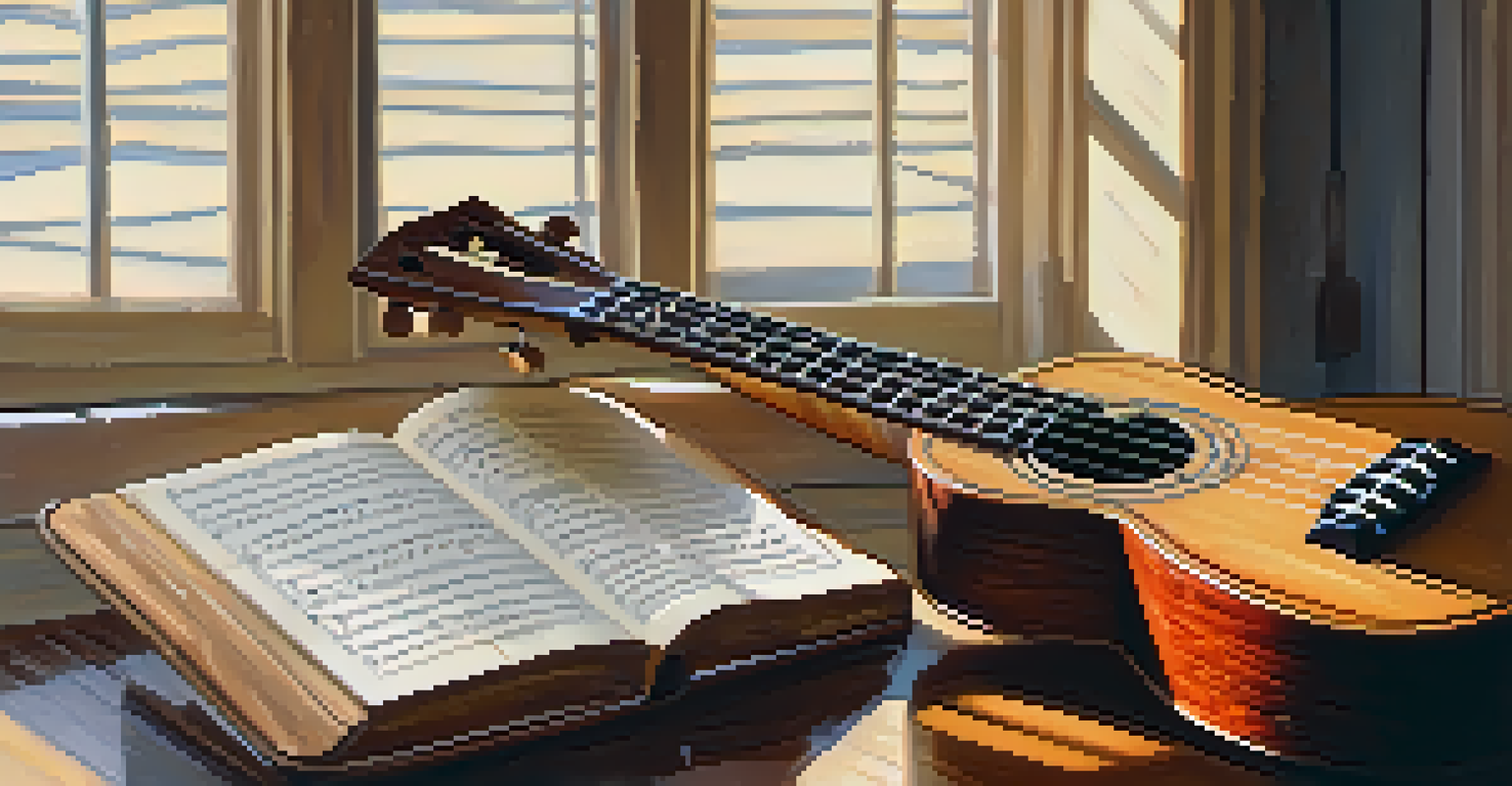Combining Harmonics and Tapping for Unique Ukulele Sounds

Understanding Harmonics on the Ukulele
Harmonics are a delightful technique that brings a new dimension to your ukulele playing. Essentially, they occur when you lightly touch a string at certain points while plucking it, producing a bell-like sound. This technique can add a magical quality to your music, making it stand out beautifully.
Music can change the world because it can change people.
For ukulele players, harmonics typically appear at the 5th, 7th, and 12th frets. When you master these spots, you'll be able to create ethereal melodies that float above your regular chords. As you practice, you'll discover how these high-pitched notes can intertwine with your songs, adding layers of texture.
Incorporating harmonics into your playing is not just about hitting the right notes; it’s also about timing and dynamics. Experiment with the volume and rhythm of your harmonics to see how they can influence the overall feel of your music. You'll find that harmonics can transform a simple strum into an enchanting experience.
What is Tapping and Its Benefits?
Tapping is a technique where you use your fingers to tap on the fretboard, allowing you to produce notes without strumming. This method can create a percussive sound that adds an exciting rhythm to your playing. Think of it as having a mini drum solo right on your ukulele!

The beauty of tapping lies in its versatility; it allows you to play complex melodies and harmonies that would be difficult to achieve through traditional strumming. By using both hands, you can create intricate patterns and even imitate other instruments. This unique sound can elevate your ukulele performance to a new level.
Master Harmonics for Unique Sounds
Harmonics add a magical quality to your ukulele playing, allowing you to create ethereal melodies that enhance your music.
When combined with harmonics, tapping can create a rich tapestry of sound. Picture yourself playing a rhythmic tapping pattern while simultaneously producing harmonics. The result is a captivating blend that keeps your audience engaged and intrigued.
Combining Harmonics and Tapping Effectively
To create unique sounds, you'll want to seamlessly blend harmonics and tapping in your playing. Start by selecting a simple chord progression and experiment with adding harmonics on top. Once you feel comfortable, introduce tapping patterns that complement the harmonics for a richer sound.
The beautiful thing about learning is that no one can take it away from you.
For instance, you might tap a melody on the higher frets while allowing harmonics to ring out on the lower strings. This layering technique creates a beautiful contrast, drawing listeners in with its complexity. Practice is key, so don't hesitate to try various combinations until you find a sound that resonates with you.
As you experiment, pay attention to how each technique influences the other. You may find that certain tapping patterns work better with specific harmonic notes. Embrace the exploration, and don't shy away from trying out unusual combinations to discover your unique style.
Tips for Practicing Harmonics and Tapping
When it comes to mastering harmonics and tapping, consistent practice is crucial. Start with short practice sessions that focus solely on one technique at a time. Once you feel confident, gradually integrate both techniques to see how they enhance each other.
Using a metronome can help you maintain a steady rhythm while practicing tapping patterns. This tool can be particularly beneficial when you start combining these techniques, as it ensures that your harmonics and tapping align beautifully. Remember, patience is key; learning takes time, and small steps lead to significant progress.
Enhance Rhythm with Tapping
Tapping introduces a percussive element to your playing, enabling you to produce complex melodies and harmonies without strumming.
Recording yourself can also provide valuable insight into your playing. Listening back allows you to identify areas for improvement and recognize what sounds great. Celebrate your progress, and don't hesitate to share your discoveries with fellow ukulele enthusiasts!
Exploring Different Musical Genres
One of the exciting aspects of combining harmonics and tapping is their versatility across various musical genres. Whether you're into pop, jazz, or even classical music, these techniques can be adapted to fit your style. Experimenting with different genres can inspire your creativity and help you discover new sounds.
For example, in a jazz piece, you might use harmonics to create a dreamy intro before transitioning into a rhythmic tapping section. This blend can add an unexpected twist to familiar tunes, keeping your audience on their toes. Embrace the freedom to explore and let your musical influences guide your experimentation.
Attending live performances or watching online tutorials can provide inspiration and new ideas for your own playing. Observe how other musicians incorporate these techniques, and don't hesitate to borrow ideas while adding your personal touch. The beauty of music lies in its ability to evolve, so let your creativity shine!
Creating Original Compositions with Techniques
Once you've gained confidence in combining harmonics and tapping, consider using these techniques to craft your original compositions. Start by brainstorming themes or emotions you'd like to express through music. This approach helps create a strong foundation for your composition.
Next, play around with various chords and melodies, integrating harmonics and tapping where it feels natural. Let your intuition guide you as you create sections that flow together, showcasing the unique sounds you've developed. Remember, there are no rules in creativity; allow yourself to explore and discover what resonates with you.
Blend Techniques for Original Compositions
Combining harmonics and tapping fosters creativity, allowing you to craft unique compositions that reflect your musical voice.
Sharing your compositions with others can also be a rewarding experience. Whether it's through social media or local jam sessions, showcasing your work can inspire fellow musicians and spark meaningful conversations. Embrace the journey of creating music that reflects your individuality and passion.
Conclusion: Embrace Your Unique Ukulele Sound
Combining harmonics and tapping opens up a world of possibilities for your ukulele playing. By exploring these techniques, you not only enhance your skills but also discover your unique musical voice. The journey of mastering these methods is as rewarding as the music you create.
As you continue to practice and experiment, remember to stay patient and enjoy the process. Each small improvement contributes to your overall growth as a musician. Celebrate your progress, and don't be afraid to share your discoveries with the ukulele community.

Ultimately, the goal is to have fun and express yourself through your music. So pick up your ukulele, start experimenting, and let the beautiful sounds of harmonics and tapping inspire your creativity!